|
Black Diamond Advanced Technologies SwitchBack™
Rugged UMPC with configurable "BackPacks" and reconfigurable architecture
(by Conrad H. Blickenstorfer -- view review as PDF)
The SwitchBack™ is a compact rugged computer that offers much more than meets the eye, and what meets the eye is already considerable. Looking at the picture below you see a compact handheld with a wide-format display and plenty of rubber bumper protection. It's a computer based on the UltraMobile PC platform Microsoft proposed a couple of years ago. You can operate it via touch, stylus, navigation diamond or a built-in pointing device. There is also a modified QWERTY layout for keyboard input. What you can't see in the picture is the BackPack that attaches to the computer and communicates with it through a high-speed interface. What you also can't see is the SwitchBack's revolutionary reconfigurable internal FPGA architecture that makes it much more than a standard PC.
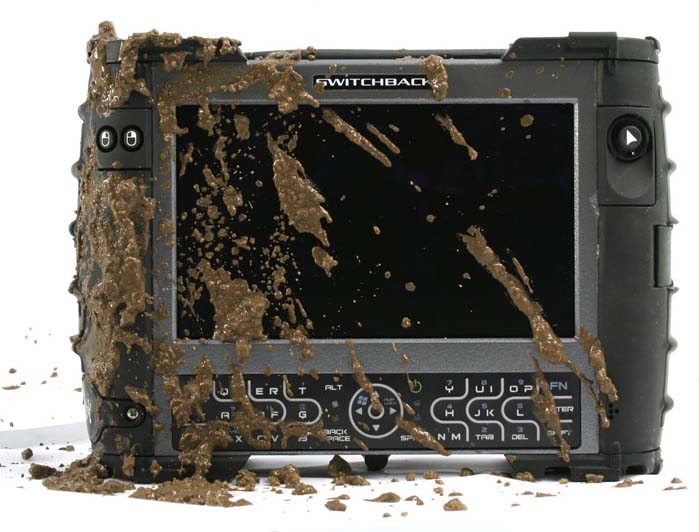
Before we get into the unique aspects of the SwitchBack, a few comments on the machine's overall concept and design. When Microsoft announced the UltraMobile PC (UMPC) in March of 2006, we immediately felt it was a platform uniquely suited for rugged mobile computers. However, while the first generation of UMPCs was all consumer-grade, the designers of what would become the SwitchBack saw the potential of a ruggedized UMPC. 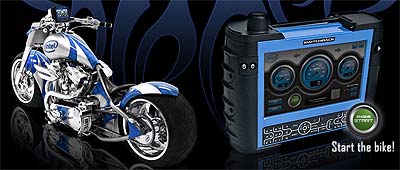 The concept was announced in the Fall of 2006 and attracted substantial attention by prospective customers and media alike. The concept was announced in the Fall of 2006 and attracted substantial attention by prospective customers and media alike.
Even Intel was so impressed that they used the SwitchBack in an Intel-themed Orange County Choppers motorcycle custom-built to commemorate Intel's 30 years in embedded computing. The SwitchBack could not only handle the intense environmental exposure on a chopper and perform standard computing tasks, it also operated the kickstand, rear view cameras, tachometer and speedometer and various other aspects of the chopper.
BackPacks
A visually stunning design, the SwitchBack PC could have gotten by on looks alone but the visionary design team knew that vertical market customers have varying and often very unique interface requirements. As a result they created the BackPack, a system of modules that screw onto the backside of the SwitchBack to provide additional connectivity. The standard module includes a half dozen common ports (a PC Card slot, a USB port, serial and VGA connection and audio in/out) whereas custom BackPacks may include a camera, mag-stripe reader, laser or RFID scanner, biometrics, high definition video, or just about anything else a customer may need. The main body of a SwitchBack module has a 3.6 x 4.6 inch footprint and is about 0.8 inches thick.
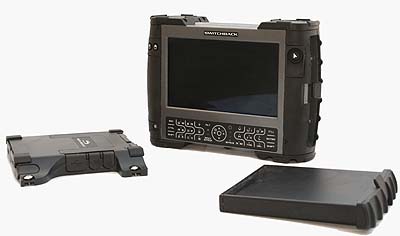 RMT can create custom modules for specific applications and also offers the "FlexPack" BackPack, a pre-engineered circuit board assembly that can quickly be adapted to support just about any external device. BackPack modules have an o-ring gasket to seal against the backside of the computer and are firmly held in place via four Philips screws. The computer runs without a BackPack, and BackPacks can be replaced as needed by the user. The BackPack modules have a tough plastic shell and protective rubber bumpers on all four corners. The packs are color-coordinated with the main SwitchBack units and nicely fit into the overall design.
RMT can create custom modules for specific applications and also offers the "FlexPack" BackPack, a pre-engineered circuit board assembly that can quickly be adapted to support just about any external device. BackPack modules have an o-ring gasket to seal against the backside of the computer and are firmly held in place via four Philips screws. The computer runs without a BackPack, and BackPacks can be replaced as needed by the user. The BackPack modules have a tough plastic shell and protective rubber bumpers on all four corners. The packs are color-coordinated with the main SwitchBack units and nicely fit into the overall design.
This concept of replaceable backpack modules not only gives the SwitchBack its name, but also solve the problem of providing a range of connectivity on a small and compact platform. This way, customers can either use the base unit without a BackPack if they don't need anything other than the single onboard USB port, or attach the standard or a custom BackPack. A very sensible solution.
Design and construction
The SwitchBack is a compact but not insubstantial package. The main unit measures 7.4 x 5.9 inches and is a bit over two inches thick. A typical BackPack will add from three quarters of an inch to the thickness. Our review unit weighed 3.85 pounds with the standard BackPack attached. The system unit alone weighs in at an even three pounds. The housing and chassis are made of magnesium alloy and have a dark gunmetal-gray finish. Almost the entire unit is additionally encased in elastomeric protection, with the left and right sides having a rubberized finish for easy holding.
The pictures below show the front and all four sides of the SwitchBack:
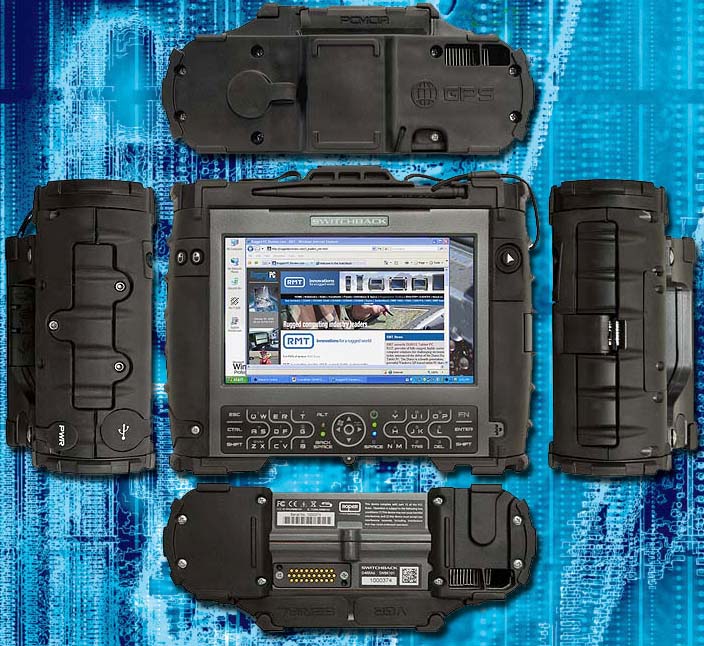
The front shows the unit's LCD display that measures 5.6 inches diagonally. It is a wide-format TFT display with a 16:9 aspect ratio and 1024 x 600 WSVGA resolution. This translates into a razor-sharp image with about 212 pixels per inch. That is significantly sharper than even the Apple iPhone's display, which has a resolution of about 162 pixels per inch. Above the display is a garage for the computer's 4-inch plastic stylus that's tethered to the computer with a 10-inch string. On the upper left are left and right mouse buttons, on the upper right a pointing device. Below the display is the SwitchBack's somewhat unique keyboard whose QWERTY layout is split in two by a centrally located navigation diamond.
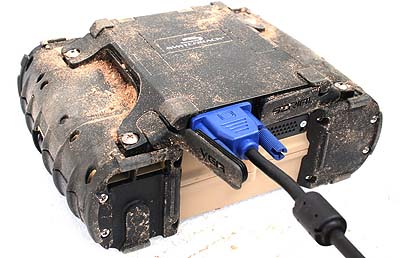 The left side shows the hard drive cover secured by three Allen screws as well as the DC power input and a USB 2.0 port, both with the protected rubber plugs in place. The plugs are screwed onto the computer and can easily be replaced. The hard drive in our review unit was an 80GB Toshiba 1.8-inch MK8009GAH unit spinning at 4,200 rpm.
The left side shows the hard drive cover secured by three Allen screws as well as the DC power input and a USB 2.0 port, both with the protected rubber plugs in place. The plugs are screwed onto the computer and can easily be replaced. The hard drive in our review unit was an 80GB Toshiba 1.8-inch MK8009GAH unit spinning at 4,200 rpm.
The right side shows the hot-swappable Li-Polymer battery. It is a 12.6V/3,850mAH unit that's integrated into the overall design and provides 48.5 watt-hours. A spring-loaded clasp holds the battery pack in place.
The bottom shows the surface-mount docking station connector and the heat exchanger vent.
On the top and bottom views you can see the attached BackPack. It is the standard version with serial and video ports at the bottom and the PC Card slot on top. All BackPack ports have individual soft rubber plugs that seal the ports with triple skirts inside the plugs. Above to the right you can see a BackPack in action.
Ever heard of Field Programmable Gate Array technology?
This is where it gets interesting, and this is where the SwitchBack takes an entirely different approach to computing. It may look just like a ruggedized ultra-mobile PC, but it is more. That's because the designers of the SwitchBack did not use a standard plain-vanilla system architecture where the CPU and chipset sit on a motherboard and control the entire computer. Instead, they chose the Xilinx Virtex 5 FPGA platform.
What is the Xilinx Virtex 5 FPGA? It is a platform that is optimized for high-performance embedded processing, digital signal processing, and high-speed connectivity, and thus a system integrator's dream. FPGA stands for Field Programmable Gate Array and refers to a class of programmable, reconfigurable chips. 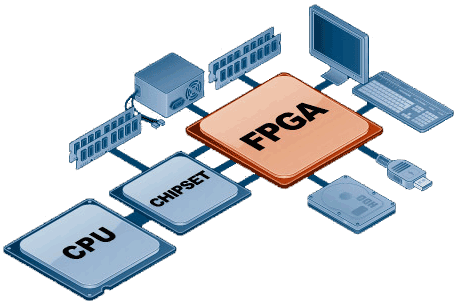 The FPGA can be programmed as a circuit board, a virtual CPU, a storage device, or as a combination of all three. The programming itself is not permanent; it can be redone even in the field. What that means is that often-used software processes can be coded to become part of the FPGA. Xilinx, the company that makes the FPGAs, also creates so called "intellectual property cores," processing blocks that can be plugged into a system and used for certain purposes. The SwitchBack still has a conventional CPU and chipset, but they assume the roles of peripherals to the FPGA. The block diagram to the right shows how it all fits together (source: RMT website).
The FPGA can be programmed as a circuit board, a virtual CPU, a storage device, or as a combination of all three. The programming itself is not permanent; it can be redone even in the field. What that means is that often-used software processes can be coded to become part of the FPGA. Xilinx, the company that makes the FPGAs, also creates so called "intellectual property cores," processing blocks that can be plugged into a system and used for certain purposes. The SwitchBack still has a conventional CPU and chipset, but they assume the roles of peripherals to the FPGA. The block diagram to the right shows how it all fits together (source: RMT website).
How does one harness the inherent power of an FPGA? Well, for example, the SwitchBack can perform true multi-tasking by not only sharing processing with the conventional Intel processor, but also by running multiple processes independently from one another within its own logic (the FPGA has its own hardware processor core. The system is also configured to free conventional CPU resources by delegating low-level functions to the FPGA where they are processed in parallel. The SwitchBack, for example, has hard-coded DSP "slices" that allow totally independent signal processing for converting video streams, process complex algorithms, or handle multiple calculations simultaneously. The FPGA can also be used to handle mission critical data or equipment control that would continue even if the conventional processor were to halt.
The application potential of the Xilinx Virtex 5 Field Programmable Gate Array is theoretically unlimited. Systems can be configured to match very specific needs such as custom logic interfaces, network security, cryptography, medical imaging, real time conversions, etc. To take advantage of this approach, the SwitchBack is set up to offload some system processes to the FPGA, but the real payoff comes through custom processes configured for specific applications. In a sense, the approach is not unlike using a System on Module in conjunction with a configurable carrier or solution board. NASA used Xilinx FPGAs in critical applications for both the lander and rover vehicles of the Mars Exploration missions. Many other companies have used FPGAs in applications from mobile handsets to Formula 1 race cars to video switchers, security cameras, automotive telematics and much more. Imagine what an FPGA-based super-compact rugged mobile system can be used for!
How do you do it? That is not entirely trivial. Xilinx offers numerous FPGA programming courses through its network of authorized training providers. And RMT has a quick-and-easy programming tool that creates flash images from the compiled bitstreams generated by Xilinx tools. RMT also sells a special firmware development kit for customers who wish to merge just about any kind of hardware with the SwitchBack.
Why did the designers of the SwitchBack choose this interesting, but in the rugged industry largely unknown, approach? Because the project was originally conceived with the intent to compete in the defense market where being able to plug into vehicles, radios and numerous different standards and devices was essential. A whole community of VHDL coders considers this approach the way to go, but things are entirely more complex than just loading a custom app. VHDL stands for Very-High-Speed Integrated Circuit Hardware Description Language and was developed for the US Department of Defense.
What it boils down to is that the SwitchBack has sort of a dual Clark Kent/Superman personality. It can function as a standard PC thanks to its Intel processor, but it can also tackle complex, sophisticated tasks at record speed thanks to its FPGA technology.
That said, we still ran our standard benchmarking suite, Passmark Software's PerformanceTest 6.1, to examine the SwitchBack's performance in "Clark Kent" mode. Passmark's benchmark suite runs about 30 tests covering CPU, 2D graphics, 3D graphics, memory, and disk and then computes scores for each category and an overall PassMark score. For comparison, we're listing the numbers of two other systems, RMT's own Celeron-equipped Duros and the Getac E100 tablet with its super-efficient 800MHz Intel A110 processor. The results were as follows:
|
PERFORMANCE COMPARISON
|
RMT Duros
|
RMT SwitchBack
|
Getac E100
|
|
Processor
|
1.0GHz Celeron M 373
|
1.0GHz Celeron M
|
800MHz Intel A110
|
|
Thermal Design Power (TDP)
|
5.0 watts
|
5.0 watts
|
3.0 watts
|
|
CPU Mark
|
249.5
|
236.3
|
207.2
|
|
2D Graphics Mark
|
169.1
|
142.4
|
174.7
|
|
Memory Mark
|
189.6
|
179.7
|
155.5
|
|
Disk Mark
|
189.4
|
163.8
|
200.2
|
|
3D Graphics Mark
|
54.5
|
64.7
|
63.1
|
|
Overall PassMark
|
169.7
|
156.6
|
148.3
|
Again, the above results strictly show the performance of the SwitchBack's Intel processor and its conventional sub-systems, but not the "afterburners" that kick in when the FPGA comes online and performs certain specific tasks at very high speed.
Operation
The SwitchBack requires getting used to in several respects. That's because it does a lot of things differently from a standard notebook and tablet computer. Part of it is the form factor of the ultra-mobile platform itself. Microsoft conceived it as a small, compact tablet that you hold with both hands and use your thumbs to operate.
That brings up some design challenges. While it is relatively easy to thumbtype on a Blackberry, a UMPC is much wider and so the designers of the SwitchBack came up with a novel approach that splits a waterproof membrane keyboard into a left and a right half, with the navigation keys in the center. The layout itself is standard QWERTY, but operation borrows from cellphone texting where tapping numeric keypad keys a number of times will generate the desired letter. On the SwitchBack, 20 of the 26 letters of the alphabet are arranged in pairs and share a key, whereas the remaining six have their own key. So if you want to type a "Q" you tap once; for the neighboring "W" you tap the same key twice. The overall look and design of the keyboard reminds of the RAZR cellphone which, of course, was and is a huge hit.
The pointing device, likewise, required a different approach. You need to apply firm and steady pressure to the small black rubber pointer. Increased pressure accelerates the cursor, less pressure makes it go slow. This works quite well, but you need to get used to it.
The display is a pleasure to use. Its incredible sharpness conveys a sense of crispness and precision, yet text and icons are not so small as to become difficult to read. The horizontal viewing angle is very wide. The vertical one much less so and there is considerable color shift. The backlight can be set manually or you can leave it in automatic mode where it is adjusted through a light sensor by the FPGA.
The unit does warm up and the fan is a bit loud for my taste. Of course, we tested the machine in a quiet lab environment; outdoors the slight fan noise is hardly noticeable.
Wireless
The RMT SwitchBack comes with 802.11b/g WiFi, Bluetooth, and integrated civilian GPS capable of receiving WAAS and EGNOS differential corrections. All wireless systems can easily be turned on or off via the Status and Control Panel described below.
The Status and Control Panel
The RMT SwitchBack comes with a Status and Control panel that has six tabs on its main window together with input voltage and the status of Function, Num-Lock, Caps-Lock and Shift-Lock. The available screens are as follows:
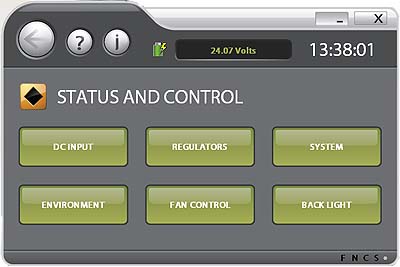
- DC Input: Shows where the SwitchBack gets its power from: DC, the main battery, or the backup battery. It also shows the remaining charge in the main and backup batteries. The DC Input window can be toggled with the Regulators window that shows the status of eight regulated voltages in the system.
- Regulators: Shows the status of eight regulated voltages in the system, and can be toggled with the DC Input window.
- System: Shows the versions of internal hardware and software. From here you can also perform system updates and turn power on and off to the GPS, WiFi and Bluetooth components.
- Environment: In this mode you can see the x, y, and z values reported by the SwitchBack's accelerometers. The screen also shows whether the unit has experienced a free fall or excessive motion.
- Fan Control: This screen shows the temperature readouts from four sensors in the system. It also shows CPU clock speed in % (at high temperatures the CPU may slow itself down). There is also a degree of manual control over fan speed.
- Back Light: Shows backlight brightness and lets you toggle brightness control between manual and automatic.
Every screen of the Status and Control Panel utility, which is based on the unit's FPGA architecture, is described in detail in a browser-based manual.
Ruggedness
The RMT SwitchBack is a fully rugged machine with a very tough magnesium alloy housing, extensive external elastomer protection, and shock-mounted electronics.
The SwitchBack was designed to meet or exceed MIL-STD-810F environmental specs for operating temperature, temperature shock, vibration, shock, and humidity. The specs differ somewhat between hard disk-based versions and machines with solid state disks. With rotating media, the operating temperature range is 32 to 122 degrees Fahrenheit and the machine can survive drops from three feet to concrete. With a solid state disk, the operating temperature range widens considerably to -4 to 131 degrees Fahrenheit, and the maximum operation drop also grows to four feet.
Sealing is at the IP67 level, with the "6" standing for complete protection against dust and the "7" for protection against immersion into water up to a depth of 3.3 feet for 30 minutes.
RMT also lists a variety of regulatory approvals that may or may not be relevant to specific customers, including FCC Part 15, Subpart B; CE Mark; and Industry Canada.
The RMT SwitchBack rugged Ultra-Mobile PC: bottom line
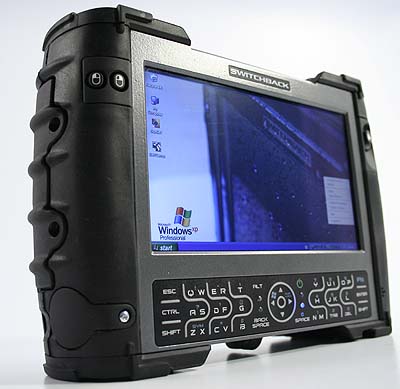 The RMT SwitchBack is an exceedingly interesting and superbly flexible machine that can fill a large number of potential requirements. As a fully rugged Ultra-Mobile PC, the compact SwitchBack provides substantial computing power even under environmentally demanding conditions. And it does so with a minuscule footprint of 7.4 x 5.9 inches and weighing just over three pounds.
The RMT SwitchBack is an exceedingly interesting and superbly flexible machine that can fill a large number of potential requirements. As a fully rugged Ultra-Mobile PC, the compact SwitchBack provides substantial computing power even under environmentally demanding conditions. And it does so with a minuscule footprint of 7.4 x 5.9 inches and weighing just over three pounds.
Should field operation require more than a single USB port, RMT's modular "BackPack" system adds almost unlimited connectivity and expansion. And it's not just ports; BackPacks can also provide camera, mag-stripe reader, laser or RFID scanner, biometrics, high definition video, etc., or custom-designed functionality.
The unit's 5.6-inch sunlight viewable display is bright and incredibly sharp with 1024 x 600 pixel WSVGA resolution. It has a passive touch screen. There is also a navigation diamond and a pointing device. A unique QWERTY keyboard combines conventional and numeric keypad functionality.
The SwitchBack is a very rugged unit that is totally sealed against dust and can even handle immersion in water. It also has a very wide operating temperature range, can handle drops, shock and vibration. Note that environmental specs vary between hard disk and solid state disk units.
What truly sets the SwitchBack apart is its unique processor architecture where a standard Intel processor is a peripheral to a Xilinx Virtex 5 FPGA platform that, with special programming, can perform complex, sophisticated tasks at record speed. Those who harness this power will find in the SwitchBack a compact, rugged machine of unparalleled flexibility.
-- Conrad H. Blickenstorfer
RMT SwitchBack Specs:
| Type |
Rugged UltraMobile PC
|
| Processor |
1GHz Intel Celeron M with 533 MHz FSB; Xilinx Virtex 5 LX30T FPGA |
| Display Chipset |
Intel 915GM |
| OS |
Windows XP Professional (Windows Vista and Linux optional)
|
| Memory |
512/2048MB DDR II DRAM |
| Display |
5.6-inch/1024 x 600 pixel WSVGA; sunlight viewable |
| Digitizer |
passive touch screen |
| Keyboard |
Backlit condensed QWERTY keyboard |
| Storage |
80-120GB 1.8-ich hard disk; up to 32GB solid state disk
|
| Expansion slots |
With standard BackPack: 1 PC Card Type II
|
| Housing |
Magnesium alloy housing with elastomer grips and bumpers |
| Size (inches) |
7.4 x 5.9 x 2.2 (system unit) |
| Weight |
3.0 lbs.
|
| Operating temperature |
With hard disk: 32 to 122 degrees F; with solid state disk: -4 to 131 degrees Fahrenheit |
| Ingress protection |
Base IP67, standard BackPack IP65 |
| Drop |
Hard disk units: 3-foot drop to concrete; solid state disk: 4-foot drop to concrete |
| Power |
Hot-swappable Li-Polymer 12.6V/3,850mAH, 48.5 watt-hours ("2-4 hrs"), 9-28 VDC |
| Interface |
On system: 1 USB 2.0, power, ultra-wide backpack port; Standard BackPack: 1 additional USB 2.0, microphone, audio out, video, serial |
| Wireless options |
802.11b/g, Bluetooth 2.0, civilian GPS; optional GSM, GPRS, EDGE, UMTS, WCDMA, GPS
|
| Price |
depends on configuration |
| Contact |
Black Diamond Advanced Technology |
(copyright 2008 RuggedPCReview.com)
|



